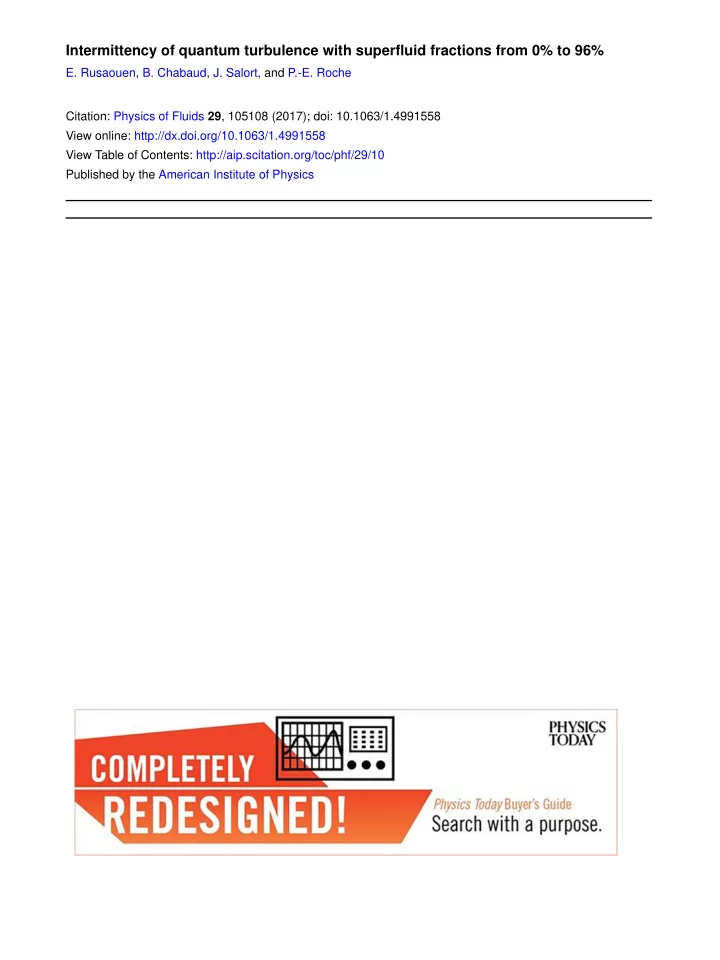

Intermittency of quantum turbulence with superfluid fractions from 0% to 96% E. Rusaouen, B. Chabaud, J. Salort, and P.-E. Roche Citation: Physics of Fluids 29 , 105108 (2017); doi: 10.1063/1.4991558 View online: http://dx.doi.org/10.1063/1.4991558 View Table of Contents: http://aip.scitation.org/toc/phf/29/10 Published by the American Institute of Physics
PHYSICS OF FLUIDS 29 , 105108 (2017) Intermittency of quantum turbulence with superfluid fractions from 0% to 96% E. Rusaouen, 1 B. Chabaud, 1 J. Salort, 2 and P.-E. Roche 1 1 University of Grenoble Alpes, CNRS, Grenoble INP, Institut N´ eel, 38000 Grenoble, France 2 University of Lyon, Ens de Lyon, University Claude Bernard, CNRS, Laboratoire de Physique, F-69342 Lyon, France (Received 21 June 2017; accepted 30 September 2017; published online 23 October 2017) The intermittency of turbulent superfluid helium is explored systematically in a steady wake flow from 1.28 K up to T > 2.18 K using a local anemometer. This temperature range spans relative densities of superfluids from 96% down to 0%, allowing us to test numerical predictions of enhancement or depletion of intermittency at intermediate superfluid fractions. Using the so-called extended self- similarity method, scaling exponents of structure functions have been calculated. No evidence of temperature dependence is found on these scaling exponents in the upper part of the inertial cascade, where turbulence is well developed and fully resolved by the probe. This result supports the picture of a profound analogy between classical and quantum turbulence in their inertial range, including the violation of self-similarities associated with inertial-range intermittency. Published by AIP Publishing. https://doi.org/10.1063/1.4991558 I. MOTIVATION AND STATE-OF-THE-ART B. Contradictory numerical predictions A. Introduction For convenience, Table I summarizes the literature review When liquid 4 He is cooled below T λ ≃ 2.18 K, it expe- presented in the following paragraph. riences a phase transition and enters a superfluid state, called The first experimental studies of intermittency in super- fluids were published in 1998 and 2011. 10,11 They focused He-II. The hydrodynamics of superfluids has fascinated physi- cists and engineers since the late 1930s, in particular for their on the low temperature regime with superfluid fractions ability to flow without experiencing any viscosity, and for the ρ s / ρ = 92% and 85% (respectively, 1.4 K and 1.56 K). Both quantification of vorticity, discovered a decade later. 1,2 Due experiments reported no difference with the intermittency of to their exotic properties, He-II and other quantum fluids have classical fluids. also attracted interest from the classical turbulence commu- In 2011, some direct numerical simulations (DNSs) nity, as it allows tackling some open problems using a fluid based on the so-called HVBK (Hall-Vinen-Bekharevich- with unique dissipative and vorticity properties. 3 The so-called Khalatnikov) continuous model 1,2 were also reported in quantum turbulence of mechanically stirred He- ii was found Ref. 11. In the HVBK model, the quantized nature of the super- to share many features with classical turbulence, 4 in particu- fluid vorticity is coarse-grained into a continuous field, which lar in the so-called inertial range of scales, where the kinetic allows describing the fluid using an Euler equation (for the energy continuously cascades from larger to smaller eddies, 5 superfluid) and a Navier-Stokes term (for the normal fluid) resulting in a Kolmogorov-Obhukov-like k ☞ 5/3 velocity power coupled by a mutual friction term. In the DNS study men- spectrum ( k is the wavenumber). The present study explores tioned above, both the low and high temperature regimes were the phenomenon of intermittency in this inertial range, an explored, with superfluid fractions of 98% and 9%, respec- effect associated with a violation of self-similarity of veloc- tively. Again no difference was found with the classical fluid ity fluctuations, which is still actively studied in classical intermittency. turbulence. 6–9 e et al. 12 reported numerical simulations In 2013, Bou´ using a shell-model 13 of the HVBK dynamics. In the low Using the Landau and Tisza two-fluid model, He- ii hydro- dynamics can be described by two interpenetrating fluids in and high temperature limits, they found the same results mutual interaction: one inviscid superfluid of density ρ s and as the previous studies. But they also reported a significant one normal fluid of viscosity µ and density ρ n = ρ ☞ ρ s enhancement of intermittency at intermediate temperatures, (where ρ is the density of He- ii ). 1,2 By changing the tem- corresponding to the window ρ s /ρ ≃ 20% − 90% (yet the perature between T λ and 0 K, the superfluid fraction ρ s / ρ exponent of the second order structure function reaches val- ues corresponding to the absence of intermittency). 12 In 2016, can be arbitrarily chosen between 0% and 100%. This tem- numerical studies by Shukla and Pandit 14 using a differ- perature dependence is a key property of the present study: it allows exploring intermittency from the Navier-Stokes case ent variant of shell model [respectively, Sabra version and ( T > T λ and ρ s / ρ = 0%), down to a nearly pure superfluid (here a GOY (Gledzer-Ohkitani-Yamada) variant] agreed on the ρ s /ρ ≃ 96%). The universality of intermittency can therefore low and high temperature limits but reported opposite results be tested versus a continuous change of fluid properties. in the intermediate window with a significant reduction or 1070-6631/2017/29(10)/105108/10/$30.00 29 , 105108-1 Published by AIP Publishing.
Recommend
More recommend